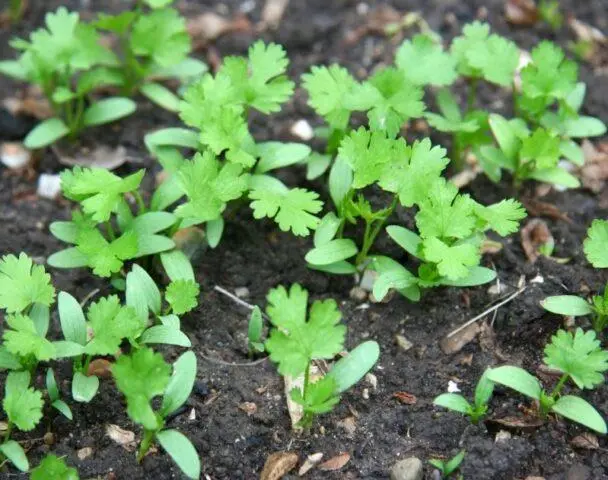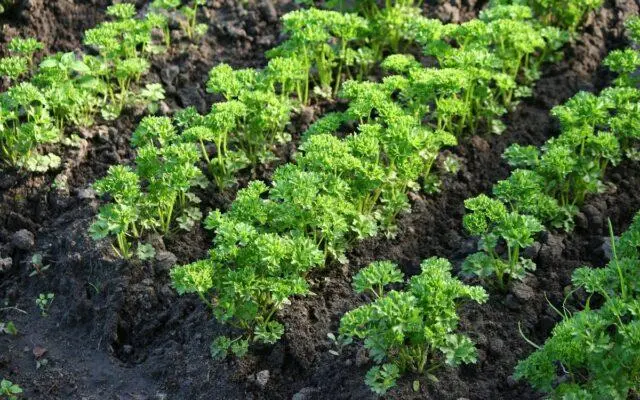Contents
Parsley sprouts in the open field after 2-3 weeks, and the deadline is 30 days. If after this the sprouts did not appear, you can not wait and try to plant another batch. Planting material must be prepared in a week, soaked in a growth stimulator and waited until the seedlings hatch.
How many days does parsley sprout after sowing in open ground
The normal germination period for parsley seeds is 15 to 20 days. Those. Seedlings should appear within three weeks of planting. Although sometimes they can form in 28–30 days, i.e. a month later. It is four weeks that can be considered a control period. If during this time the parsley has not risen, you will have to plant new seeds.
The rate of germination and emergence of seedlings is highly dependent on temperature. The warmer the earth, the faster the seedlings make their way. For example, if in a squat layer of frost (not higher than 3 degrees Celsius), the time will be delayed for several days. And if the weather is consistently warm (20 degrees and above), the seeds will sprout in 5-7 days. Therefore, a deviation from the standard terms by 1,5–2 times (both up and down) is allowed.
Sometimes articles, videos and other materials appear on the network that there is a secret in which the seeds sprout within three hours after sowing. In fact, this is not possible even in early ripening varieties. The minimum time for parsley to germinate is five days, even under the most favorable weather conditions.
What does parsley look like when it sprouts?
Parsley shoots look typical for any seedling. Sprouted parsley seeds produce thin, milky-white sprouts. Almost immediately they form the first pair of light green leaves. Then more and more new leaves begin to actively appear, the seedlings grow stronger, the stem thickens and becomes bright green.

Foliage, initially oval, eventually acquires a classic pinnate shape
What determines the germination of parsley seeds
Germination depends on a variety of factors. First of all, it is determined by the quality of seed, soil, care features and weather conditions. Therefore, you need to choose high-quality grains and provide normal care.
Quality of seeds
Most of these causes can be influenced: you should start by purchasing high quality seeds. In order for parsley to sprout, several requirements should be taken into account:
- Seeds must have high germination – they are bought from trusted suppliers with good reviews.
- Shelf life is no more than 2-3 years. The fresher the seed, the better. Seeds can be used 1–1,5 years after harvest.
- Before planting, parsley seeds should be inspected and any damaged ones removed.
Even if the seed is of high quality, it does not guarantee 70% germination. In the case of the first class, the figure is 40%, and with the second – only XNUMX%. Therefore, you need to be prepared for the fact that every third grain will not sprout and simply remain in the soil.
soil
For parsley to sprout, it requires fertile and light soil. The optimal type of soil is sandy loam; loamy, fertile soil is also suitable. It needs to be prepared in 3-4 months, i.e. in advance in autumn or spring (if sowing is pre-winter). To do this, when digging, close up a bucket of compost or humus for every 2 m2. If the soil is clayey, you will need to add 1 kg of sand or sawdust to the same area.
If the soil gives an alkaline reaction (pH = 8 or more), it is treated with vinegar (9%) at the rate of 100 ml per 10 liters. This volume is enough for 1 m2 area.
Lighting
In order for the grass to sprout well, it does not need an abundance of sunlight. You can choose both a completely open area and a shady area, for example, next to shrubs or garden trees. But there should not be a strong shadow – this may affect the growth rate.
Climate
Parsley grows well in all temperate zones. The plant is resistant to frost and drought, so the culture is bred everywhere from central and southern Our Country to the North-West, the Urals, Siberia and the Far East. In order for parsley to sprout, it can be grown in almost any area.

Culture grows well in most regions of Our Country
Processing before planting
In order for parsley to sprout, it is recommended to process the grain a week before planting. To do this, they are soaked in water (preferably in a growth stimulator solution), and then germinated on a paper napkin or in a layer of sawdust at home. Thanks to this, the first shoots will appear in 5-6 days. It is at this point that you can start planting in open ground.
The advantage of pre-germination is that poor-quality material can be sifted out immediately. In this case, seedlings can be planted at a sufficient distance so that later thinning is not involved.
What to do to quickly rise parsley
To quickly germinate parsley seeds, you can use different methods. First of all, the seed must be prepared and germinated. For cultivation, fertile and light soil is used, and they also create a greenhouse effect. Equally important is the pattern and depth of planting. If you want the grass to sprout quickly, the grains are deepened by no more than 2,5 cm. There are other methods to accelerate growth processes. For example, you can use growth stimulants (special preparations or home remedies).
Seed preparation before planting
In order for parsley to quickly form seedlings, it is recommended to germinate the seeds before planting. This method significantly increases the percentage of germination. The fact is that the grains contain a large amount of essential oils that prevent the emergence of seedlings. Under natural conditions, they enter the soil in autumn and must spend a long time in a state of physiological dormancy. Therefore, before planting, you need to “wake up” the seeds. You should act according to the following instructions:
- Put the grains in a plate with water at room temperature (or a little warmer) and let them lie down for 5-6 hours. You can add a little growth stimulant (in the form of a solution) or potassium permanganate to the water (the liquid should be slightly pink).
- Put on a damp paper towel or in a small layer of sawdust and let lie down for 5-6 days.
- At the same time, the grains can be hardened by holding them for 10–15 days in the refrigerator. If there is no time left, this step can be skipped.
- It is during this period that the seed should sprout: as soon as the white sprouts hatch, they can be transferred to the ground. It is not worth delaying – a week after germination, it’s time to plant.

Pre-germinated seeds will sprout faster
Proper landing technique
In order for parsley to sprout quickly, it must be sown correctly, withstanding two parameters:
- Depth.
- Row spacing.
The depth depends on the type of soil. Light sandy, sandy and loamy soils have a loose structure. In order for the grass to sprout confidently, the seeds can be planted at a depth of 2 cm (maximum 2,5 cm). However, the soil is also more dense (with a high content of clay). Then the depth should be a maximum of 1–1,5 cm.
In order for seedlings to be guaranteed to appear, the planting pattern is very important, i.e. spacing between adjacent rows and each seedling. If the grains are planted too tightly, then the seedlings will interfere with each other, obscuring the light and taking water and nutrients. They will have to be thinned out manually, but this is too laborious. In addition, while digging, it is easy to damage thin stems.
In order for the grass to actively form seedlings, it is recommended to observe the following seeding rate: 0,5 g of seeds per 1 m2. As a result, no more than 70–80 plants should remain in this area. A distance of 10–12 cm is left between adjacent grooves, and the grains are distributed in 3 cm increments. The planting technology is as follows:
- Clean, dig and carefully level the bed.
- Mark several grooves of small depth (up to 2 cm), orienting them in the north-south direction. The step between them is at least 10 cm.
- Plant the seeds to a depth of no more than 2 cm.
- Sprinkle with soil, without tamping.
- Pour with warm, settled water. It is better to do this from a sprayer.

In order for the culture to form seedlings, a normal (above), and not compacted (below) planting pattern is used.
Creating a greenhouse effect
It is possible to ensure fast germination of seeds so that parsley is guaranteed to sprout when creating a greenhouse effect. This is a classic technique that is used for almost any seedling. Seedlings prefer not only moist soil, but also moist air. In order for the greens to sprout, the bed after planting is covered with plastic wrap, in which small holes are first made.
Every day this film will have to be removed in order to ventilate, water the plants, and loosen the soil. After 1-1,5 months after planting, it is removed completely. Then it remains to follow only watering, fertilizing and other care activities.
The use of growth stimulants
Another proven way to achieve fast parsley sprouts is to use safe growth stimulants (one drug of your choice):
- “Epin”;
- “Kornevin”;
- “Zircon”;
- “Heteroauxin” and others.
Means must be used according to the instructions. They are diluted with water in the right amount and kept planting material for 8-12 hours. If the drugs were not at hand, you can also soak the grains in freshly squeezed aloe juice, diluted with water in a ratio of 1: 1.
Burying bags with seeds
For parsley to sprout, you can use this technique. Take dry (unprocessed) grains and pour them into a bag made of natural fabric. Then bury in the soil that has not yet warmed up to a great depth (up to 35 cm) for 15 days. After that, the seed is kept in a growth stimulant solution, dried thoroughly on paper and then immediately planted.
Why parsley does not sprout in open ground
If parsley did not sprout when planted in open ground, the most common reasons for this are:
- Poor quality seeds.
- Too deep landing.
- Heavy, infertile soil.
- Extremely bad weather.
- Unmoistened soil, dry air.
Conclusion
Parsley sprouts in open ground quite quickly: if the weather is warm, sprouts will appear in a week. But if a month has passed, and there are no seedlings, this may be due to poor-quality planting material, a large planting depth, or improper care.










